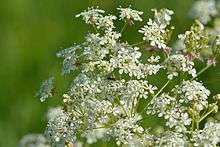Anthriscus sylvestris
Anthriscus sylvestris, known as cow parsley,[2] wild chervil,[2] wild beaked parsley, or keck,[2] is a herbaceous biennial or short-lived perennial plant in the family Apiaceae (Umbelliferae),[3] genus Anthriscus. It is also sometimes called mother-die (especially in the UK), a name that is also applied to the common hawthorn. It is native to Europe, western Asia and northwestern Africa; in the south of its range in the Mediterranean region, it is limited to higher altitudes. It is related to other diverse members of Apiaceae, such as parsley, carrot, hemlock and hogweed. It is often confused with Daucus carota which is known as Queen Anne's lace or wild carrot, also a member of the Apiaceae.[4]
| Anthriscus sylvestris | |
|---|---|
 | |
| Scientific classification | |
| Kingdom: | Plantae |
| Clade: | Tracheophytes |
| Clade: | Angiosperms |
| Clade: | Eudicots |
| Clade: | Asterids |
| Order: | Apiales |
| Family: | Apiaceae |
| Genus: | Anthriscus |
| Species: | A. sylvestris |
| Binomial name | |
| Anthriscus sylvestris (L.) Hoffm. | |
| Synonyms[1] | |
|
Synonyms list
| |
Description
The hollow stem grows to a height of 60–170 cm (24–67 in), branching to umbels of small white flowers. Flowering time is mid spring to early summer.
The tripinnate leaves are 15–30 cm (5.9–11.8 in) long and have a triangular form. The leaflets are ovate and subdivided.
Cow parsley grows in sunny to semi-shaded locations in meadows and at the edges of hedgerows and woodland. It is a particularly common sight by the roadside. It is sufficiently common and fast-growing to be considered a nuisance weed in gardens. Cow parsley's ability to grow rapidly through rhizomes and to produce large quantities of seeds in a single growing season has made it an invasive species in many areas of the United States. Vermont has listed cow parsley on its "Watch List" of invasive species, while Massachusetts has banned the sale of the plant. It is classed as a Class B Noxious Weed in the State of Washington since 1989,[4] where its sale is also banned. In Iceland, cow parsley has been classified as an alien invasive species.[5]
Uses
Cow parsley is considered to be edible, its flavour is sharper than garden chervil, with a hint of carrot, to which it is related.
Resemblance to family members
Cow parsley can be mistaken for similar-looking poisonous plants, among them poison hemlock and fool's parsley.
The same holds true as to giant cow parsley/giant hogweed (Heracleum mantegazzianum), the sap of which can cause severe burns after coming in contact with the skin.
Gallery
.jpg) Illustration from Köhler's Medicinal Plants
Illustration from Köhler's Medicinal Plants
 The base of a second-year plant in September and a young layer (Warming 1884)
The base of a second-year plant in September and a young layer (Warming 1884)
References
- The Plant List: A Working List of All Plant Species, retrieved 20 December 2015
- "Anthriscus sylvestris". Germplasm Resources Information Network (GRIN). Agricultural Research Service (ARS), United States Department of Agriculture (USDA). Retrieved 15 December 2017.
- Webb, D.A., Parnell, J. and Doogue, D. 1996. An Irish Flora. Dundalgan Press Ltd, Dundalk. ISBN 0-85221-131-7
- "Wild chervil". King County.
- Ágengar plöntur (Invasive plants). Náttúrufræðistofnun Íslands (Icelandic Institute of Natural History. Retrieved on May 2nd 2019. (In Icelandic).
External links
- "Anthriscus sylvestris". Plants For A Future.
| Wikimedia Commons has media related to Anthriscus sylvestris. |